Day 2 of a three day Easter weekend tour today. It was another glorious, sunny day but a bit cooler than yesterday, in a fresher ENE wind. Still, it was lovely weather to be out again. We spent most of the day further east along the north Norfolk coast today.
Holkham has been very busy over Easter, with the car park filling up as lots of visitors came out enjoying the good weather, so we figured we would need to get in and out early. As we walked west on the inland side of the pines, there were lots of warblers singing in the trees and bushes – Blackcap, Willow Warbler, Chiffchaff and Sedge Warbler.
A Swallow flew over the pines heading east and we heard a Greenshank flying over too, calling. We saw our first Jays of the weekend in the poplars and lots of Speckled Wood butterflies flying over the path.

Salts Hole was quiet – part from the noisy Egyptian Geese flying in and out of the trees. Continuing on to Washington Hide, we could hear a Grasshopper Warbler reeling and the more rhythmic song of a Reed Warbler singing too in the reedbed, but both stayed well hidden.
Continuing on to Joe Jordan Hide, the first things we spotted as we opened the flaps were the two Cattle Egrets. They were some way off at first, not with the cows, feeding in a low-lying wet area further back. Then they flew in to join the cattle, coming a bit closer where we could get a better look at them in the scope. We watched one of them picking insects off the back of a calf which was lying down in the grass.
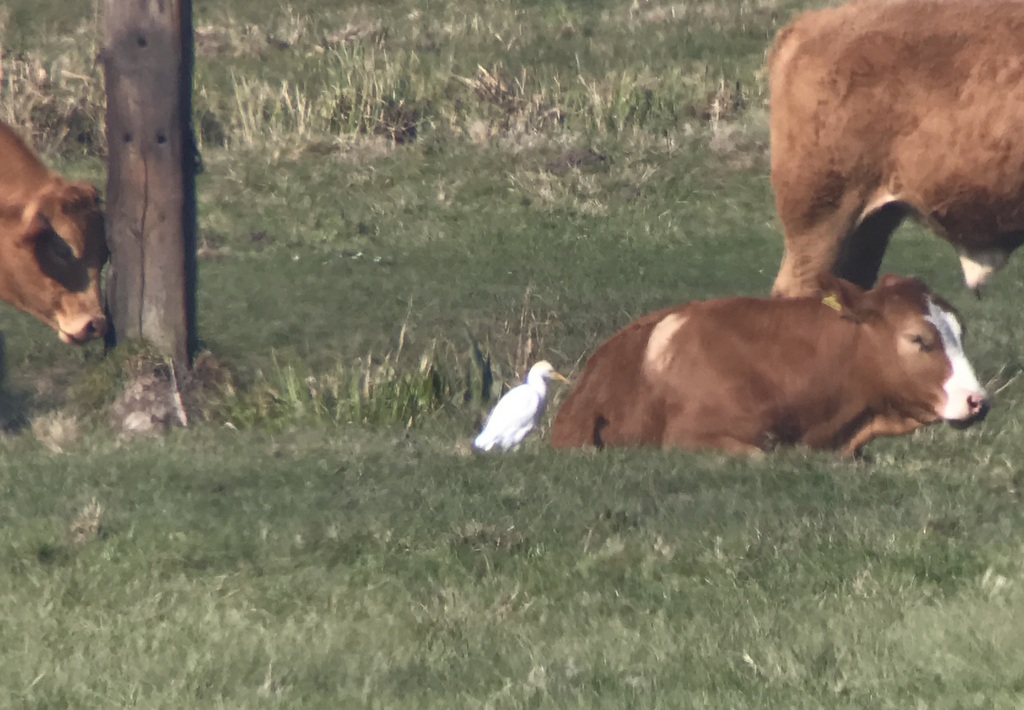
There was lots of Spoonbill activity this morning, with regular comings and goings as birds flew down from the trees to the big pool below and back up again. One or two birds were bathing, while others were feeding in the shallow water or looking for nest material around the margins.
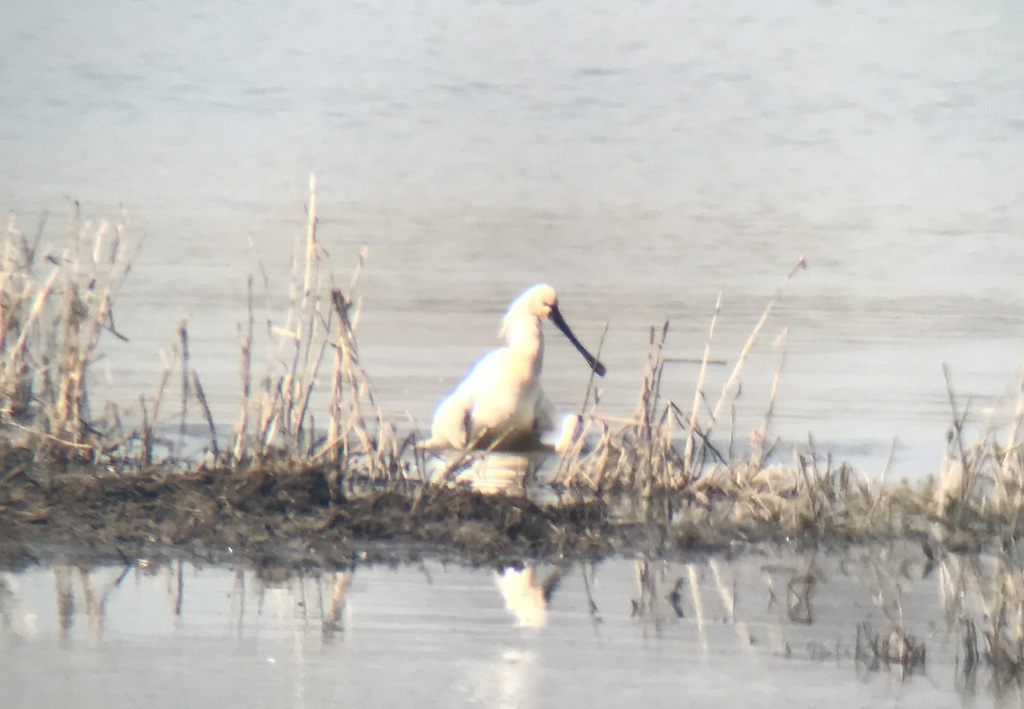
A Grey Heron was standing motionless out on one of the smaller wet areas in the grass and several Little Egrets flew in and out of the trees too. A selection of ducks, Avocets and Redshanks were also down around the pools. A Mistle Thrush was feeding down in the grass below the hide.
We could have spent a lot longer here, but we wanted to move on before it got too busy. By the time we got back to Lady Anne’s Drive, there were lots of cars already parked most of the way down towards the main road now, and lots of people, dogs and horses, mostly heading straight out to the beach. We made a quick visit to The Lookout café, to use the facilities, and a Little Ringed Plover dropped down onto the pool in front calling. Then we made quick escape!
We drove east to Kelling next. There were a few warblers singing as we walked up the lane, including one or two Lesser Whitethroats rattling in the hedge. When we got to the copse, we found a few people looking for the Pied Flycatcher which had been seen here earlier, but there had been no sign of it for over an hour apparently. A Chiffchaff and a Blackcap were singing in the trees.
Rather than linger here, we continued straight on to the Water Meadow. A Common Sandpiper was bobbing up and down, feeding along the muddy edge, and a single Ruff was also feeding on the margin at the back. A dusky grey Spotted Redshank, still moulting into breeding plumage, was feeding out in the deeper water in the middle amongst several noisy Black-tailed Godwits. A nice selection of spring migrant waders.
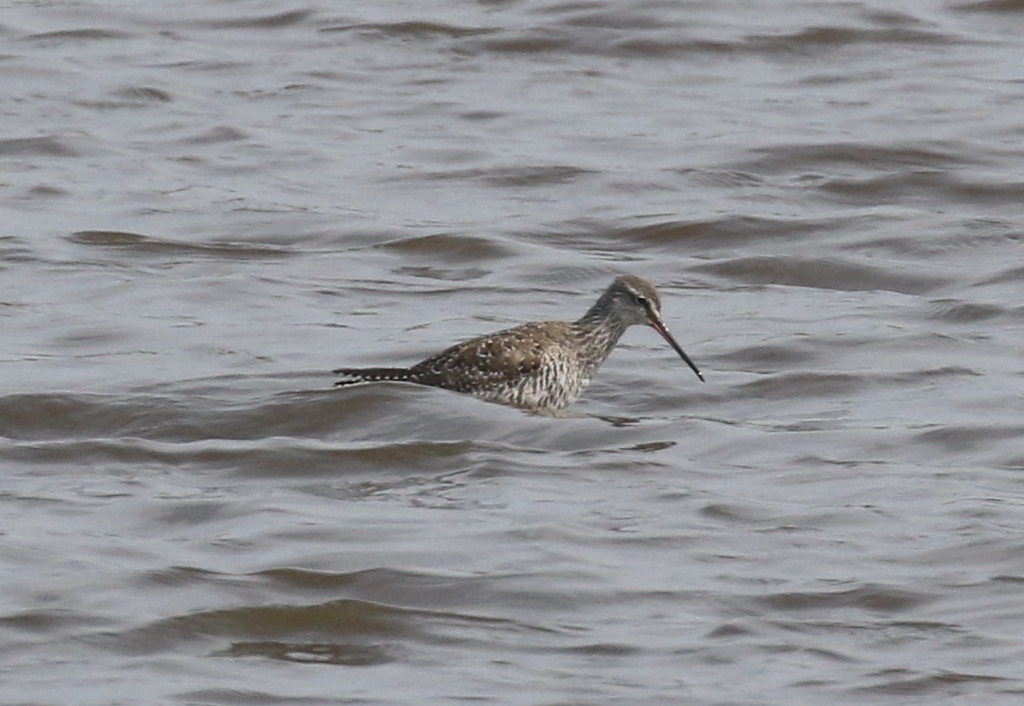
With lots of people coming down to look for the flycatcher, it was busy down here now, with a steady stream of people walking past the pool. There had been a Wood Sandpiper here earlier but that had apparently flown off, and there was no sign of any Green Sandpiper or Greenshank either. In spring, birds are in a hurry to get to their breeding grounds, so they often don’t stay long. A lone Dunlin did fly in and drop down onto the shore while we were there, a migrant stopping off briefly to feed.
We walked back up the lane to where the cows were grazing at the other end of the Water Meadow. We could just see one or two Yellow Wagtails in the long grass, but there was still no sign of the Blue-headed Wagtail which had been with them earlier. Again it had presumably moved on quickly.
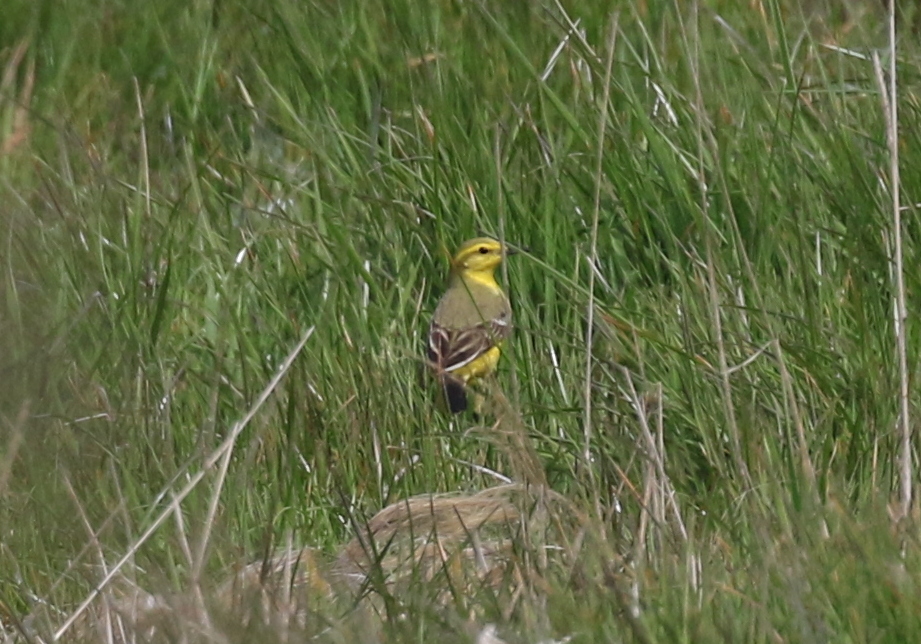
Two of the locals who just arrived from Cley told that two Wood Sandpipers were showing well from the East Bank there, so we decided to head straight over. As we parked at Walsey Hills, we noticed a Common Buzzard flying out of the trees with a big gap in one wing – possibly it had been shot at. It didn’t seem to be affecting its flying ability too badly though, and we watched as it decided to have a tussle with a second paler Buzzard over the trees.

A quick walk out on the East Bank was instantly rewarded with the two Wood Sandpipers, feeding on the small pools just below bank. They were very close and we had a really good look at them, dainty little birds with white-spangled upperparts and a noticeable pale supercilium. Wood Sandpipers are passage migrants here, passing through from their wintering grounds in Africa to breed in Scandinavia, and as we had found at Kelling can often move on quickly in spring, so it was great to catch up with them.

There was a smart rusty male Ruff on the pools here too, just moulting into breeding plumage. It had already lots most of its pale grey/brown and white winter plumage, but was yet to get an ornate ruff and headdress. Male Ruffs have a two stage moult, getting a new set of body feathers first, before moulting the head and neck again later. There is no point carrying round that ruff for any longer than is necessary! Over the next month or so, this bird will acquire the rest of its breeding plumage before moving on to its breeding grounds in Scandinavia.
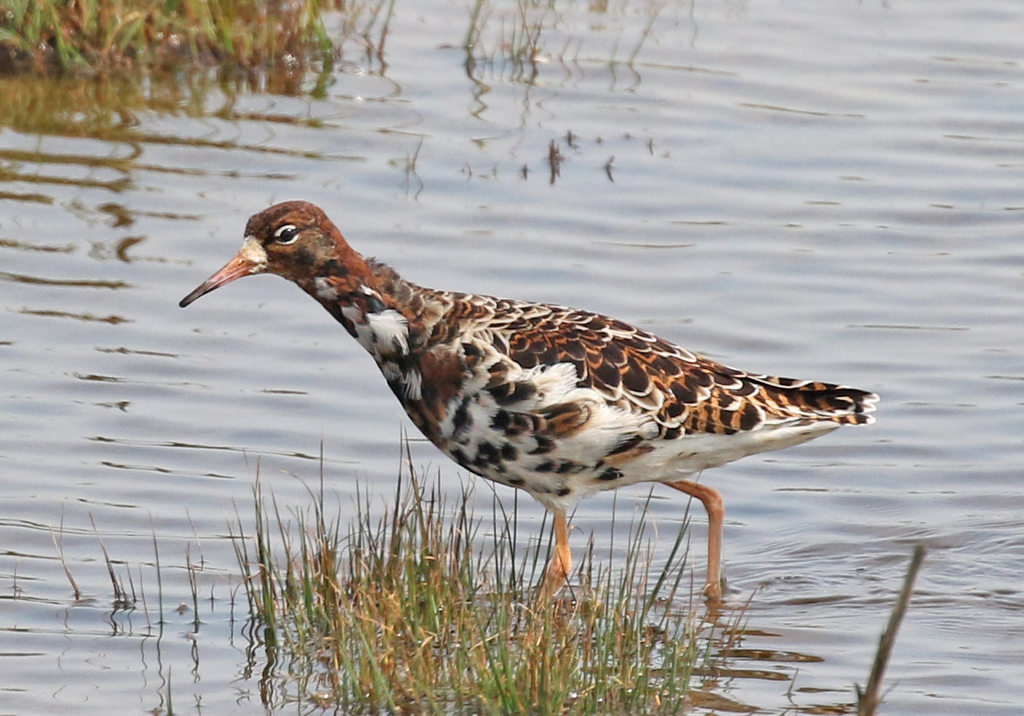
It was rather cool up on the bank in the fresh easterly breeze. We had a quick scan of the rest of the marshes but otherwise we could only see a few ducks on Serpentine, mainly Teal and Gadwall. There were a few gulls on Pope’s Pool. It was already around 1pm so we decided to head back to the Visitor Centre for lunch.
After lunch, we drove back towards Salthouse for a quick look at the Iron Road. The pools here are drying out fast now, and looked to be quiet at first when we scanned from the road. Still, we walked down for a closer look and found a nice selection of birds still. The highlight was a smart White Wagtail which was feeding on the dried out mud on the front edge. We could see its bright silvery-grey upperparts, contrasting with the black top to its head.

There were a few waders too. Two Little Ringed Plovers were well camouflaged down on the dry mud, two Dunlin were picking around the edge of the water, and there were several Ruff towards the back, including a couple of females, Reeves. One of the Reeves was noticeably much smaller than the male Ruff it was with. A Marsh Harrier flew round low over the reeds beyond.
Carrying on back west, we stopped next at Stiffkey Fen. Two Grey Partridges were in the field across the road – we could see their heads when they stood up. The male was mostly keeping lookout, with the female presumably feeding, as it only put its head up once or twice. There were more warblers singing here – a Lesser Whitethroat rattling in the hedge, and one or two Blackcaps in the copse. A Yellowhammer flew over.
From the path down along the river, we could see a Green Sandpiper on the Fen beyond, but by the time we had got the scopes up it had disappeared behind the reeds. Continuing on up onto the seawall, we found two Green Sandpipers now feeding along the back edge. Four Little Ringed Plovers were flying round, chasing each other. There were also lots of Avocets, a few Redshanks and Black-tailed Godwits, and a single Grey Plover on the mud at the back.
There are always lots of gulls on the Fen through the summer, with a good number of breeding pairs of Black-headed Gulls. As we looked through, we could see two or three Common Gulls in amongst them. Then we noticed the Little Gull standing on the edge of one of the islands. It was much smaller than the Black-headeds, with white wing-tips and brighter orange legs. It is still moulting into breeding plumage, lacking a complete black hood yet. It took off, and we watched it hawking over the water, dip feeding, very agile, more like a tern, its pale silvery-grey upperwings contrasting with its blackish underwings.

After making our way back to the van, we continued on our way west to Wells. As we walked down the track, we scanned the pools. There were lots of ducks here on the flooded fields – Teal, Gadwall, Shoveler, and a few lingering Wigeon. Scanning through carefully, we found the pair of Garganey in with them, what we had come to see. Through the scopes we could see the bold white head stripe on the drake, when it lifted its head from feeding, and the ornate plumes on the grey back.
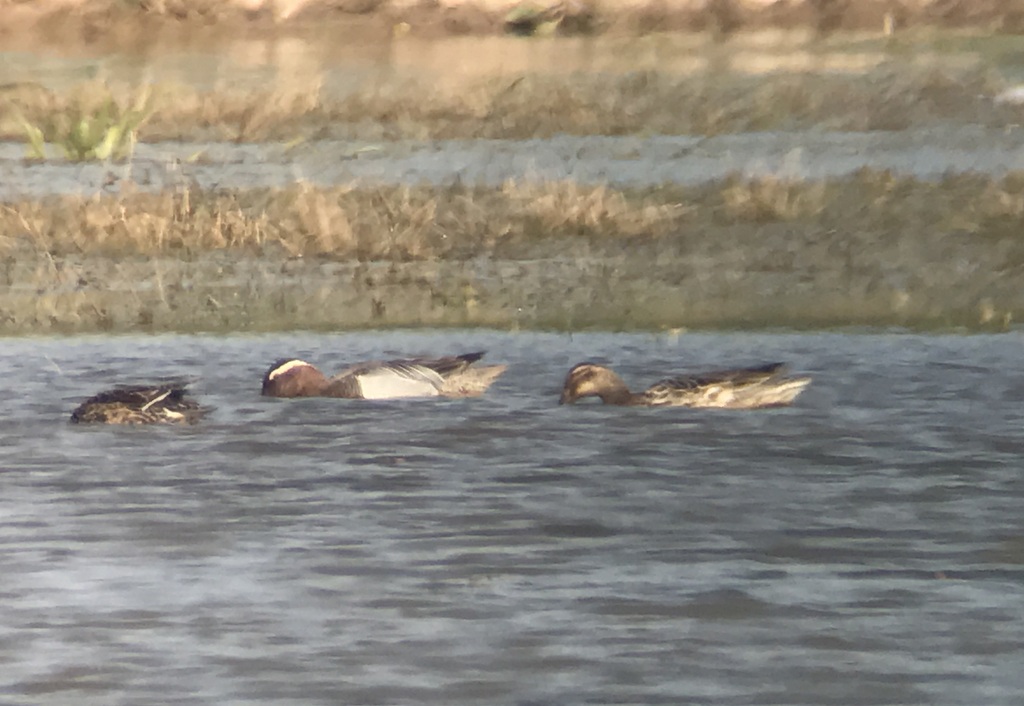
There were lots of waders on the pool on the other side of the track. Two Spotted Redshanks were feeding in the shallow water, one was noticeably more dusky grey than the other, further advanced in its moult into its black breeding plumage. There was a Greenshank and another Wood Sandpiper with them too. There were certainly plenty of spring passage waders dropping in along the coast today.
A few Ruff were out on the pools too and scanning the clumps of rushes and wet grass carefully, we found two Common Snipe feeding. A Golden Plover flew overhead calling, and dropped down onto the grass at the back of the pool, presumably another migrant heading north.
There had apparently been a Jack Snipe seen earlier on another pool by the seawall, so we went over to look for it. We found several more Common Snipe here, but no sign of the Jack Snipe. Presumably it had gone into the thick grass and gone to sleep, as they typically do. Another Common Sandpiper was feeding along the bottom of the bank at the back. A male Marsh Harrier was displaying, twisting and tumbling high overhead.
It was time to wrap up now and head back. We had enjoyed a great three days out, with lots of spring migrants, in lovely weather and great company. Classic Norfolk April birding.
















